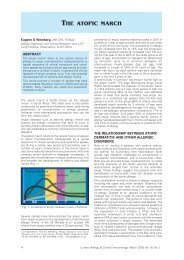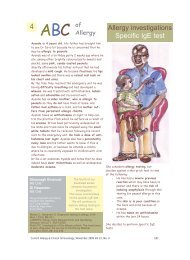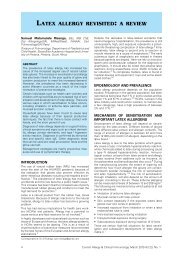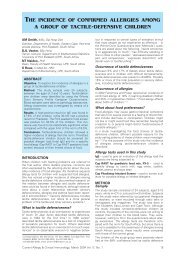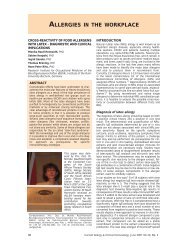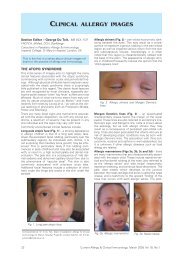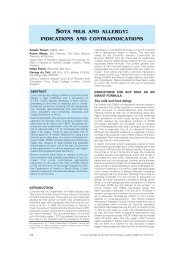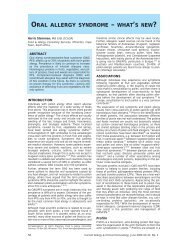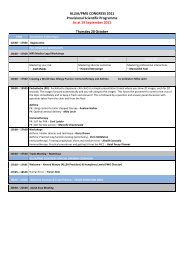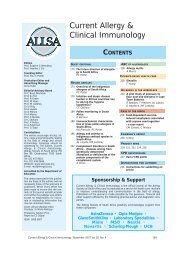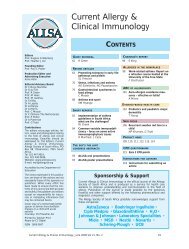with memory T-cell phenotypes. 18 These are yieldinggreater underst<strong>and</strong>ing in chronic viral infections, e.g.the demonstration of skewing of memory T-cell subsetsin HIV rapid progressors. 21 At the same time, thereare extremely rapid advances in the underst<strong>and</strong>ing ofthe regulation of immune responses by regulatory T-cells 22 <strong>and</strong> IL-23/IL-27 pathway, 23 among other pathwaysof immune regulation. Immune dysregulation dueto defective regulatory T-cell function in primaryimmune deficiencies has also recently beendescribed. 24 I anticipate that application of theseadvances in the future will yield new insights <strong>and</strong> be ofvalue in the evaluation of adult patients presenting withunusual infections, where currently available relativelycrude immune assays usually fail to demonstrate anyabnormality.Declaration of conflict of interestThe author declares no conflict of interest.REFERENCES1. Ozsahin H, Arredondo-Vega FX, Santisteban I, et al. Adenosinedeaminase deficiency in adults. Blood 1997; 89: 2849-2855.2. Russel MW, Kilian M. Biological activities of IgA. In: Mestecky J,Lamm ME, Strober W, Bienenstock J, McGhee JR, Mayer L, eds.Mucosal <strong>Immunology</strong>, 3rd ed. Elsevier Academic Press, 2005: 267-2903. Hattingh C, Green F, Bubb MD, Conradie JD. The incidence of IgAdeficiency amongst blood donors in Kwazulu-Natal. S Afr J Sci1996; 92: 206-209.4. Ross IN, Thompson RA. Severe selective IgM deficiency. J ClinPath 1976; 29: 773-777.5. Zaka-ur-Rab Z, Gupta P. Pseudomonas septicaemia in selectiveIgM deficiency. Indian Pediatrics 2005; 42: 961-962.6. Notarangelo LD, Lanzi G, Peron S, Dur<strong>and</strong>y A. Defects of classswitchrecombination. J <strong>Allergy</strong> Clin Immunol 2006; 117: 855-864.7. Mansouri D, Adimi P, Mirsaedi M, et al. Primary immune deficienciespresenting in adults: seven years of experience from Iran.J Clin Immunol 2005; 25: 385-391.8. Boyle J. Characteristics of health outcomes of patients with primaryimmune deficiency diseases in the United States. J <strong>Allergy</strong>Clin Immunol 2004;113: S43.9. Cunningham-Rundles C, Bodian C. Common variable immunodeficiency:<strong>Clinical</strong> <strong>and</strong> immunological features of 248 patients. ClinImmunol 1999: 92: 34-48.10. Kampmann B, Hemingway C, Stephens A, et al. Acquired predispositionto mycobacterial disease due to autoantibodies to IFN-γ.J Clin Invest 2005; 115: 2480-2488.11. Lammas DA, Drysdale P, Ben-Smith A, et al. Diagnosis of defectsin the type 1 cytokine pathway. Microbes Infect 2000; 2: 1567-1578.12. Soderstrom T, Soderstrom R, Avanzi A, et al. Immunoglobulin Gsubclass deficiencies. Int Arch <strong>Allergy</strong> Appl Immunol 1987; 82:476.13. Lekstrom-Himes JA, Gallin JI. Immunodeficiency diseases causedby defects in phagocytes. N Engl J Med 2000, 343: 1703-1714.14. De Vries E. Patient-centred screening for primary immunodeficiency:a multi-stage diagnostic protocol designed for non-immunologists.Clin Exp Immunol 2006; 145: 204-214.15. Biron CA, Nguyen KB, Pien GC, Cousens LP, Salazar-Mather TP.Natural killer cells in antiviral defense: function <strong>and</strong> regulation byinnate cytokines, Annu Rev Immunol 1999; 17: 189-220.16. Orange JS. Human natural killer cell deficiencies <strong>and</strong> susceptibilityto infection. Microbes Infect 2002; 2: 1545-1558.17. Cunningham-Rundles C. Immune deficiency: office evaluation <strong>and</strong>treatment. <strong>Allergy</strong> Asthma Proc 2003; 24: 409-415.18. Casazza JP, Betts MR, Price DA, et al. Acquisition of direct antiviraleffector functions by CMV-specific CD4+ T lymphocytes withcellular maturation. J Exp Med 2007; 203: 2865-2877.19. Hatam L, Schuval S, Bonagura VR. Flow cytometric analysis of naturalkiller cell function as a clinical assay. Cytometry 1994; 16: 59-68.20. Arkwright PD, Abinun M, Cant AJ. Autoimmunity in human primaryimmunodeficiency diseases. Blood 2002; 99: 2694-2702.21. Zhang JY, Zhang Z, Wang X, et al. PD-1 up-regulation is correlatedwith HIV-specific memory CD8+ T-cell exhaustion in typical progressorsbut not in long-term nonprogressors. Blood 2007; 109:4671-4678.22. Chess L, Jiang H. Regulation of immune responses by T cells.N Engl J Med 2006; 354: 1166-1176.23. Kastelein RA, Hunter CA, Cua DJ. Discovery <strong>and</strong> biology of IL-23<strong>and</strong> IL-27: related but functionally distinct regulators of inflammation.Annu Rev Immunol 2007; 25: 221–242.24. Torgerson, TR, Ochs HD. Regulatory T cells in primary immunodeficiencydiseases. Curr Opin <strong>Allergy</strong> Clin Immunol 2007; 7: 515-521.<strong>Clinical</strong> <strong>Immunology</strong>: Principles <strong>and</strong> Practice, 3/eExpert Consult with UpdatesEdited by RR Rich, TA Fleisher, WT Shearer, H W Schroeder II, A J Frew <strong>and</strong> CM Wey<strong>and</strong>April <strong>2008</strong>, hardcover, approx. 1616 pp, 700 illus., 203 x 254 mm, R3 800Written <strong>and</strong> edited by international leaders in the field, this book has, through two best-selling editions, beenthe place to turn for authoritative answers to your toughest challenges in clinical immunology. Now in full color<strong>and</strong> one single volume, the 3rd edition brings you the very latest immunology knowledge - so you can offer yourpatients the best possible care. The user-friendly book <strong>and</strong> the fully searchable companion web site give youtwo ways to find the answers you need quickly...<strong>and</strong> regular online updates keep you absolutely current.Key features Leading international experts equip you with peerless advice <strong>and</strong> global best practices to enhance yourdiagnosis <strong>and</strong> management of a full range of immunologic problems. A highly clinical focus <strong>and</strong> an extremely practical organization expedite access to the answers you need inyour daily practice.New to this edition Cutting-edge coverage of the human genome project, immune-modifier drugs, <strong>and</strong> many other vital updateskeeps you at the forefront of your field. A new organization places scientific <strong>and</strong> clinical material side by side, to simplify your research <strong>and</strong> highlightthe clinical relevance of the topics covered. A multimedia format allows you to find information conveniently, both inside the exceptionally user-friendlybook <strong>and</strong> at the fully searchable companion web site. Regular updates online ensure that you'll always have the latest knowledge at your fingertips. Includes many new <strong>and</strong> improved illustrations <strong>and</strong> four colour design.Orders: Medical Book Seller, Tel Jackie: 083 303 8500, fax (021) 975-1970,E-mail: jackie@medbookseller.co.za<strong>Current</strong> <strong>Allergy</strong> & <strong>Clinical</strong> <strong>Immunology</strong>, <strong>March</strong> <strong>2008</strong> Vol 21, No. 1 7
APPROACH TO THE CHILD WITH RECURRENTINFECTIONS – PRESENTATION ANDINVESTIGATION OF PRIMARY IMMUNODEFICIENCYMonika Esser, MMed Paed<strong>Clinical</strong> <strong>Immunology</strong> & Rheumatology Service,<strong>Immunology</strong> Unit, NHLS & Stellenbosch University,Department of Pathology, Tygerberg Academic HealthComplex, Tygerberg, South AfricaABSTRACTInfants <strong>and</strong> children, as part of normal developmentof immune competence, experience <strong>and</strong> survivemany infections – mostly subclinical – <strong>and</strong> a fairnumber of clinically apparent infectious illnesses.Mature immunity is generally achieved by the time achild reaches school age. An abnormal number <strong>and</strong>severity of infections are the hallmarks of deficientimmunity.The commonest causes of immunodeficiencyworldwide are malnutrition, HIV <strong>and</strong> immunosuppressive-iatrogenicagents.Primary immunodeficiencies (PIDs), generally theresult of genetic defects, are rare conditions. Theseare suspected when a child or adult suffers fromrecurrent, prolonged, severe or unusual infectionswhich would not normally cause problems inotherwise healthy individuals.Early diagnosis of PID improves quality of life asmany PIDs are treatable. The related morbidity <strong>and</strong>mortality which inevitably accompanies a delayeddiagnosis can often be prevented. Unfortunatelydelayed diagnosis <strong>and</strong> its consequences are frequentlyseen in practice in South Africa.Algorithms for detecting PIDs exist for clinical <strong>and</strong>laboratory investigations. Guidelines for patient managementare easily accessed via the Internet <strong>and</strong>antenatal diagnosis <strong>and</strong> genetic counselling arebecoming a reality. Gene transfer may offer hope forcures eventually.An overview of approach to history, clinical examination<strong>and</strong> appropriate laboratory investigation forsuspected diagnosis of PID in children is presented.INTRODUCTIONWith the advent of the African AIDS p<strong>and</strong>emic the term‘immunodeficiency’ has gained new meaning. Some ofthe infection patterns seen as a result of HIV infectionare similar to those seen in the patient with PID.Cluster Differentiation – CD4 counts have becomecommon knowledge <strong>and</strong> medical staff are aware ofthe need for HIV testing in the patient with recurrentor unusual infections. But when HIV infection has beenexcluded, there is no evidence of malnutrition, allergieshave been addressed as possible causes, the child hasbeen taken out of the crèche, second-h<strong>and</strong> smokingCorrespondence: Dr M Esser, <strong>Immunology</strong> Unit, Department ofPathology, PO Box 19063, Tygerberg 7505, Cape Town, South Africa.Tel. 021-938-5228, fax 021-938-4005, e-mail monika@sun.ac.zahas been avoided <strong>and</strong> recurrent infections continue,the question of primary or inborn deficiencies as acause should arise. The majority of these present ininfancy with a 5:1 male over female predominancebecause of the X-linked inherited PIDs, but a largenumber are not recognised until adolescence or earlyadulthood.They may occur as frequently as 1/2 000 live births formilder defects 1 <strong>and</strong> even as frequently as 1/400 in thecase of IgA deficiencies which are asymptomatic in themajority of cases. There are currently more than 120PIDs with known genetic causes – the recent increasein classifications has been facilitated by the completionof the Human Genome Project in April of 2003.Accurate figures for prevalence in South Africa are notavailable but probably approach those quoted internationallyfor the well-recognised syndromes. Unusuallyhigh incidences of late complement deficiencies havehowever been reported by Orren et al. 2 for the Caperegion <strong>and</strong> other genetic immunodeficiencies particularto the Southern African region may yet be researched.Despite awareness about immunodeficiency related tothe HIV p<strong>and</strong>emic, the investigation of the child withrecurrent infections is still frequently delayed inSouth Africa, <strong>and</strong> if diagnosed correctly, is managed suboptimallyin many cases. Even in developed countriessuch as the UK diagnostic delays for antibody deficienciesof a median of 5.5 years in adults <strong>and</strong> 2.5 years inchildren have been shown. 3 Late diagnosis in this groupof patients is tragic as effective intravenous preparationsof gammaglobulin became available as early as 1980. 4Seamless monitoring is essential but follow-up is frequentlyinterrupted <strong>and</strong> suboptimal with transfer of theadolescent to the adult service – as happens to manyyoungsters with other chronic illnesses too.WHAT IS UNACCEPTABLE/ABNORMALFOR A CHILD IN TERMS OF RECURRENTINFECTIONS?Most doctors with some years of clinical experiencedevelop a good investigative threshold for this question.It is surprising therefore that the diagnosis of PID isoften equally if not more delayed in more affluentcommunities in South Africa. The easy access to broadspectrumantibiotics, nutritional support – even hyperalimentation,antireflux procedures <strong>and</strong> the practice ofchanging doctors if all else fails often mark the trail ofa late diagnosis in the face of good health care access.Neglect <strong>and</strong> lack of resources however may precipitatea more catastrophic course <strong>and</strong> paradoxically sometimesearlier investigation <strong>and</strong> diagnosis.Healthy young children may experience up to 6 upperrespiratory tract infections per year <strong>and</strong> even 10 ormore if exposed to day care, schoolgoing sibs or smoking.5 These infections should clear promptly <strong>and</strong> in thecase of bacterial infections they should respond rapidlyto antibiotics.While respiratory <strong>and</strong> gastrointestinal infections arecommon in immunodeficiency, skin infections such asulcerating BCG marks or with organisms such as8 <strong>Current</strong> <strong>Allergy</strong> & <strong>Clinical</strong> <strong>Immunology</strong>, <strong>March</strong> <strong>2008</strong> Vol 21, No. 1



